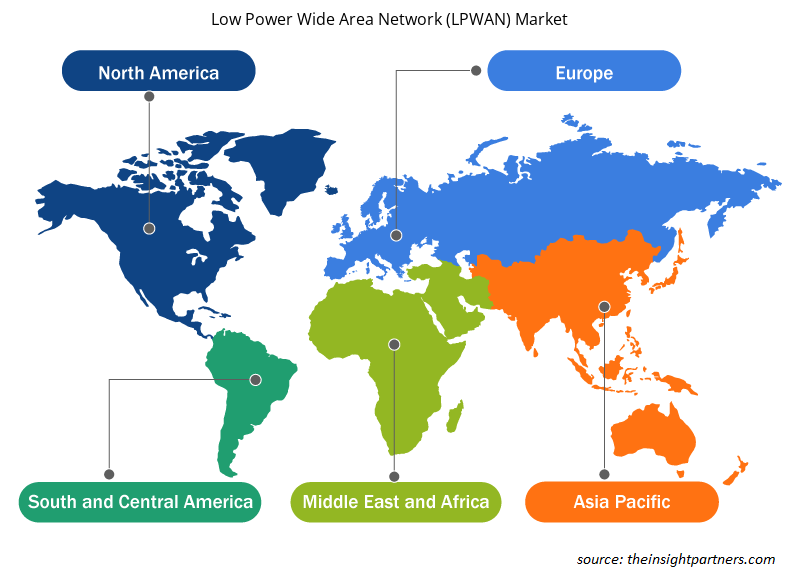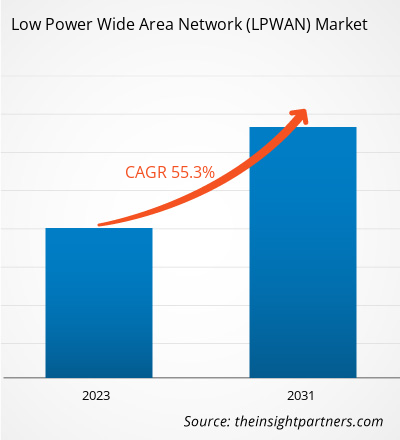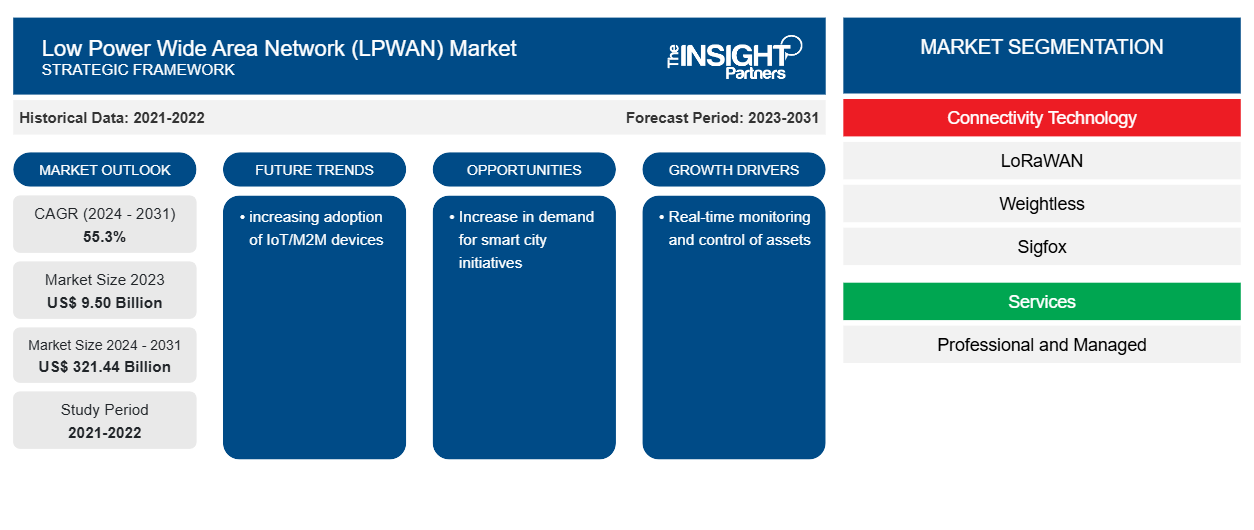Der Markt für Low Power Wide Area Networks (LPWAN) soll von 9,50 Milliarden US-Dollar im Jahr 2023 auf 321,44 Milliarden US-Dollar im Jahr 2031 wachsen; von 2024 bis 2031 wird ein durchschnittliches jährliches Wachstum des Marktes von 55,3 % erwartet. Das exponentielle Wachstum der Smart-City-Infrastruktur dürfte ein wichtiger Trend auf dem Markt bleiben.
Marktanalyse für Low Power Wide Area Networks (LPWAN)
Das Wachstum des Low-Power-WAN-Marktes wird vor allem durch Faktoren wie die steigende Nachfrage nach Smart-City-Initiativen und den steigenden Bedarf an Echtzeitüberwachung und -steuerung von Anlagen vorangetrieben. Diese Faktoren tragen zur Entwicklung und Implementierung von Low Power Wide Area Networks (LPWAN) bei, die eine effiziente und kostengünstige Konnektivität für eine breite Palette von Anwendungen in Smart Cities und Asset-Management-Systemen ermöglichen.
Marktübersicht für Low Power Wide Area Networks (LPWAN)
Low-Power Wide Area Network (LPWAN) ist eine drahtlose Technologie, die Fernkommunikation bei niedrigen Bitraten ermöglicht. Sie wurde speziell dafür entwickelt, stromsparende Geräte über beträchtliche Entfernungen hinweg zu verbinden und dabei langsame Datengeschwindigkeiten beizubehalten. LPWANs bieten eine kostengünstige, stromsparende und weiträumige Verbindung, was sie für Geräte vorteilhaft macht, die eine lange Akkulaufzeit und die Fähigkeit benötigen, Daten über große Entfernungen zu senden. Der LPWAN-Markt dürfte in den kommenden Jahren aufgrund der steigenden Nachfrage nach stromsparender, weiträumiger Konnektivität für Geräte des Internet of Things (IoT) schnell wachsen. Verschiedene Branchen, darunter Landwirtschaft, Gesundheitswesen, Logistik und Transport, implementieren die LPWAN-Technologie.
Passen Sie diesen Bericht Ihren Anforderungen an
Sie erhalten kostenlose Anpassungen an jedem Bericht, einschließlich Teilen dieses Berichts oder einer Analyse auf Länderebene, eines Excel-Datenpakets sowie tolle Angebote und Rabatte für Start-ups und Universitäten.
- Holen Sie sich die wichtigsten Markttrends aus diesem Bericht.Dieses KOSTENLOSE Beispiel umfasst eine Datenanalyse von Markttrends bis hin zu Schätzungen und Prognosen.
Markttreiber und Chancen für Low Power Wide Area Networks (LPWAN)
Echtzeitüberwachung und -kontrolle von Vermögenswerten zur Förderung des Marktes
Die LPWAN-Technologie bietet eine ideale Lösung für Unternehmen, die ihre Anlagen, darunter Industrieanlagen, landwirtschaftliche Maschinen und Fahrzeuge, effektiv überwachen und verwalten möchten. Unternehmen können den Zustand ihrer Maschinen in Echtzeit überwachen, wodurch sie potenzielle Probleme proaktiv erkennen und beheben können, bevor sie eskalieren. Dadurch wird das Risiko unerwarteter Ausfallzeiten und kostspieliger Reparaturen verringert. Darüber hinaus können Unternehmen den Standort ihrer Fahrzeuge verfolgen, Routen optimieren und das Fahrerverhalten überwachen, was zu einer verbesserten Betriebseffizienz und Kosteneinsparungen führt. technology offers an ideal solution for businesses seeking to effectively monitor and manage their assets, including industrial equipment, agricultural machinery, and vehicles. Businesses can monitor the condition of their machinery in real time, which enables them to proactively identify and address potential issues before they escalate, mitigating the risk of unexpected downtime and costly repairs. Additionally, businesses can track the location of their vehicles, optimize routes, and monitor driver behavior, resulting in enhanced operational efficiency and cost savings.
Zunahme von Smart City-Initiativen
Smart-City-Initiativen zielen darauf ab, städtische Dienstleistungen zu verbessern und die Lebensqualität der Einwohner zu steigern. Diese Initiativen basieren auf der LPWAN-Technologie (Low Power Wide Area Network), die eine kostengünstige und energieeffiziente drahtlose Konnektivität für eine große Anzahl von Geräten bietet. LPWAN ermöglicht verschiedene Anwendungen, darunter die Fahrzeug-zu-Fahrzeug- und Fahrzeug-zu-Infrastruktur-Kommunikation, die für Smart-City- Lösungen von entscheidender Bedeutung sind.LPWAN (Low Power Wide Area Network) technology, which provides affordable and energy-efficient wireless connectivity for a large number of devices. LPWAN enables various applications, including vehicle-to-vehicle and vehicle-to-infrastructure communication, which are crucial for
Segmentierungsanalyse des Marktberichts für Low Power Wide Area Network (LPWAN)
Wichtige Segmente, die zur Ableitung der Marktanalyse für Low Power Wide Area Networks (LPWAN) beigetragen haben, sind Konnektivitätstechnologie, Dienste, Anwendungen und Endbenutzer.
- Basierend auf der Konnektivitätstechnologie ist der Markt in LoRaWAN, Weightless, Sigfox, NB-IoT und Wi-SUN unterteilt. Das LoRaWAN-Segment hatte im Jahr 2023 den größten Marktanteil.
- Basierend auf den Dienstleistungen ist der Markt in professionelle und verwaltete Dienste unterteilt. Das professionelle Segment hatte im Jahr 2023 einen größeren Marktanteil.
- In Bezug auf die Anwendung wird der Markt in intelligente Straßenbeleuchtung, intelligente Zähler, intelligente Gebäude, intelligentes Abfallmanagement, intelligentes Parken sowie Anlagenverwaltung und -verfolgung unterteilt. Das Segment der intelligenten Zähler hatte im Jahr 2023 den größten Marktanteil.
- Basierend auf den Endnutzern ist der Markt in Smart City, Öl und Gas, Gesundheitswesen, Fertigung, Logistik und Transport, Landwirtschaft und Unterhaltungselektronik unterteilt. Das Smart-City-Segment hatte im Jahr 2023 den größten Marktanteil.
Low Power Wide Area Network (LPWAN) Marktanteilsanalyse nach Geografie
Der geografische Umfang des Marktberichts für Low Power Wide Area Networks (LPWAN) ist hauptsächlich in fünf Regionen unterteilt: Nordamerika, Asien-Pazifik, Europa, Naher Osten und Afrika sowie Süd- und Mittelamerika. Nordamerika dominierte den Markt für Low Power Wide Area Networks im Jahr 2023 aufgrund seiner starken industriellen Basis, der staatlichen Förderung von Innovationen und der hohen Kaufkraft. Das Wachstum in dieser Region wird hauptsächlich durch die steigende Nachfrage nach mobilen und tragbaren Geräten und den wachsenden Bedarf an IoT-Geräten getrieben. Der asiatisch-pazifische Raum wird jedoch voraussichtlich die höchste Wachstumsrate verzeichnen, angetrieben durch Faktoren wie die zunehmende Industrialisierung und die steigende Nachfrage nach Automatisierung und Digitalisierung. Die LPWAN-Technologie eignet sich besonders gut für IoT-Anwendungen in Branchen wie Smart Cities, Landwirtschaft, Logistik und Gesundheitswesen.LPWAN) market report is mainly divided into five regions: North America, Asia Pacific, Europe, Middle East & Africa, and South & Central America. North America dominated the low power wide area network market in 2023, owing to its strong industrial base, government support for innovation, and high purchasing power. The growth in this region is mainly driven by the increasing demand for mobile and wearable devices and the growing need for IoT devices. However, Asia-Pacific is projected to experience the highest growth rate, fueled by factors such as growing industrialization and rising demand for automation and digitalization. LPWAN technology is particularly well-suited for IoT applications in industries such as smart cities, agriculture, logistics, and healthcare.
Regionale Einblicke in den Markt für Low Power Wide Area Networks (LPWAN)
Die regionalen Trends und Faktoren, die den Markt für Low Power Wide Area Networks (LPWAN) während des gesamten Prognosezeitraums beeinflussen, wurden von den Analysten von Insight Partners ausführlich erläutert. In diesem Abschnitt werden auch die Marktsegmente und die Geografie von Low Power Wide Area Networks (LPWAN) in Nordamerika, Europa, im asiatisch-pazifischen Raum, im Nahen Osten und Afrika sowie in Süd- und Mittelamerika erörtert.

- Erhalten Sie regionale Daten zum Low Power Wide Area Network (LPWAN)-Markt
Umfang des Marktberichts zum Low Power Wide Area Network (LPWAN)
| Berichtsattribut | Details |
|---|---|
| Marktgröße im Jahr 2023 | 9,50 Milliarden US-Dollar |
| Marktgröße bis 2031 | 321,44 Milliarden US-Dollar |
| Globale CAGR (2024 - 2031) | 55,3 % |
| Historische Daten | 2021-2022 |
| Prognosezeitraum | 2023–2031 |
| Abgedeckte Segmente | Von Connectivity Technology
|
| Abgedeckte Regionen und Länder | Nordamerika
|
| Marktführer und wichtige Unternehmensprofile |
|
Dichte der Marktteilnehmer im Low Power Wide Area Network (LPWAN): Die Auswirkungen auf die Geschäftsdynamik verstehen
Der Markt für Low Power Wide Area Networks (LPWAN) wächst rasant, angetrieben durch die steigende Nachfrage der Endnutzer aufgrund von Faktoren wie sich entwickelnden Verbraucherpräferenzen, technologischen Fortschritten und einem größeren Bewusstsein für die Vorteile des Produkts. Mit der steigenden Nachfrage erweitern Unternehmen ihr Angebot, entwickeln Innovationen, um die Bedürfnisse der Verbraucher zu erfüllen, und nutzen neue Trends, was das Marktwachstum weiter ankurbelt.
Die Marktteilnehmerdichte bezieht sich auf die Verteilung der Firmen oder Unternehmen, die in einem bestimmten Markt oder einer bestimmten Branche tätig sind. Sie gibt an, wie viele Wettbewerber (Marktteilnehmer) in einem bestimmten Marktraum im Verhältnis zu seiner Größe oder seinem gesamten Marktwert präsent sind.
Die wichtigsten Unternehmen auf dem Markt für Low Power Wide Area Networks (LPWAN) sind:LPWAN) Market are:
- Nwave-Technologien
- SIGFOX
- Semtech Corporation
- LORIOT.IO
- Link Labs, Inc
- Waviot
Haftungsausschluss : Die oben aufgeführten Unternehmen sind nicht in einer bestimmten Reihenfolge aufgeführt.

- Überblick über die wichtigsten Akteure auf dem Markt für Low Power Wide Area Networks (LPWAN)LPWAN) Market top key players overview
Low Power Wide Area Network (LPWAN) Marktnachrichten und aktuelle EntwicklungenLPWAN) Market News and Recent Developments
Der Markt für Low Power Wide Area Networks (LPWAN) wird durch die Erhebung qualitativer und quantitativer Daten nach Primär- und Sekundärforschung bewertet, die wichtige Unternehmensveröffentlichungen, Verbandsdaten und Datenbanken umfasst. Im Folgenden finden Sie eine Liste der Entwicklungen auf dem Markt:LPWAN) market is evaluated by gathering qualitative and quantitative data post primary and secondary research, which includes important corporate publications, association data, and databases. The following is a list of developments in the market:
- Sigfox, eine in Frankreich geborene Ultraschmalband-IoT-Netzwerktechnologie, ist der LoRa Alliance offiziell als beitragendes Mitglied beigetreten. Dieser Schritt erfolgte, nachdem Sigfox Anfang 2022 einen Niedergang und einen Notverkauf erlebte und von der in Singapur ansässigen Unabiz übernommen wurde. Die neue Muttergesellschaft hat zusammen mit dem LoRaWAN-Experten Rémi Lorrain Sigfox den Einstieg in das LoRaWAN-Lager erleichtert. Diese Entwicklung ist bedeutsam, wenn man die historische Rivalität zwischen Sigfox und LoRaWAN im Bereich der Low-Power-Wide-Area-Networks (LPWAN) bedenkt., a French-born ultra-narrowband IoT network technology, officially joined the LoRa Alliance as a contributing member. This move came after Sigfox experienced a decline and fire sale in early 2022 and was acquired by Singapore-based Unabiz. The new parent company, along with LoRaWAN expert Rémi Lorrain, facilitated Sigfox's entry into the LoRaWAN camp. This development is significant considering the historical rivalry between Sigfox and LoRaWAN in the low-power wide-area network (LPWAN) space.
(Quelle: Sigfox, Pressemitteilung, Juli 2023)Sigfox, Press Release, July 2023)
- Semtech gab bekannt, dass es die Sigfox-Technologie „0G“ erfolgreich in seine LoRa-Chipsatzreihe SX126x integriert hat. Diese Integration ermöglicht Kompatibilität mit LoRaWAN und anderen LoRa-basierten Netzwerken. Diese Entwicklung ist Teil der laufenden Bemühungen von Semtech, die Sigfox-Technologie auf Chipebene zu integrieren. Zuvor hatte Semtech die Sigfox-Technologie erfolgreich in seinen preisgünstigen LCC68-Transceiver und die fortschrittliche LR-Serie integriert, die Funktionen wie GNSS mit mehreren Konstellationen und passive Wi-Fi-Scanfunktionen bietet. announced that it had successfully integrated Sigfox '0G' technology into its SX126x range of LoRa chipsets. This integration allows for compatibility with LoRaWAN and other LoRa-based networks. This development is part of Semtech's ongoing efforts to incorporate Sigfox technology at the chip level. Previously, Semtech successfully integrated Sigfox technology into its budget-friendly LCC68 transceiver and advanced LR series, which offers features such as multi-constellation GNSS and passive Wi-Fi scanning capabilities.
(Quelle: Semtech, Pressemitteilung, Dezember 2022)Semtech, Press Release, December 2022)
Marktbericht zu Low Power Wide Area Networks (LPWAN), Abdeckung und ErgebnisseLPWAN) Market Report Coverage and Deliverables
Der Bericht „Marktgröße und Prognose für Low Power Wide Area Networks (LPWAN) (2021–2031)“ bietet eine detaillierte Analyse des Marktes, die die folgenden Bereiche abdeckt:LPWAN) Market Size and Forecast (2021–2031)" report provides a detailed analysis of the market covering below areas:
- Marktgröße und Prognose für Low Power Wide Area Networks (LPWAN) auf globaler, regionaler und Länderebene für alle wichtigen Marktsegmente, die im Rahmen des Berichts abgedeckt sindLPWAN) market size and forecast at global, regional, and country levels for all the key market segments covered under the scope
- Markttrends für Low Power Wide Area Networks (LPWAN) sowie Marktdynamiken wie Treiber, Einschränkungen und wichtige ChancenLPWAN) market trends as well as market dynamics such as drivers, restraints, and key opportunities
- Detaillierte PEST/Porters Five Forces- und SWOT-Analyse
- Marktanalyse für Low Power Wide Area Networks (LPWAN), die wichtige Markttrends, globale und regionale Rahmenbedingungen, wichtige Akteure, Vorschriften und aktuelle Marktentwicklungen umfasstLPWAN) market analysis covering key market trends, global and regional framework, major players, regulations, and recent market developments
- Branchenlandschaft und Wettbewerbsanalyse, einschließlich Marktkonzentration, Heatmap-Analyse, prominenten Akteuren und aktuellen Entwicklungen für den Markt für Low Power Wide Area Networks (LPWAN).
- Detaillierte Firmenprofile
- Historische Analyse (2 Jahre), Basisjahr, Prognose (7 Jahre) mit CAGR
- PEST- und SWOT-Analyse
- Marktgröße Wert/Volumen – Global, Regional, Land
- Branchen- und Wettbewerbslandschaft
- Excel-Datensatz
Aktuelle Berichte
Erfahrungsberichte
Grund zum Kauf
- Fundierte Entscheidungsfindung
- Marktdynamik verstehen
- Wettbewerbsanalyse
- Kundeneinblicke
- Marktprognosen
- Risikominimierung
- Strategische Planung
- Investitionsbegründung
- Identifizierung neuer Märkte
- Verbesserung von Marketingstrategien
- Steigerung der Betriebseffizienz
- Anpassung an regulatorische Trends





















 Kostenlose Probe anfordern für - Markt für Low Power Wide Area Networks (LPWAN)
Kostenlose Probe anfordern für - Markt für Low Power Wide Area Networks (LPWAN)